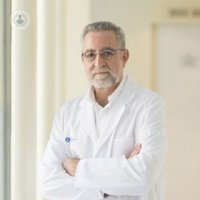interventional neuroradiology, the solution to vascular malformations and arteriovenous
Written by:Interventional neuroradiology is based in performing minimally invasive treatments in the brain or spinal through catheterizations. This medical specialty focuses mainly on two groups of pathologies. On the one hand, vascular malformations, as aneurysms and arteriovenous malformations; and other cerebral thromboses or embolisms.
How do people affect vascular malformations?
Within this type of malformations, the most common is cerebral aneurysm. It is a birth defect in the artery wall, more specifically, is the absence of one of the three layers should have the arterial wall. Thus, the impact of blood against this area of weakness, makes a blood bag called an aneurysm is formed.
The main problem is that usually this disease is not discovered until the bag (hemorrhage or stroke) is broken and, at that time, the consequences are very serious and. And is that half of patients with bleeding caused by an aneurysm die before reaching the hospital, while the other half, only 50% can resume normal life.

Vascular malformations: how an aneurysm is avoided? What is your treatment?
The key is to detect the aneurysm before blood. This requires an MRI with MRA, thus detected 95% of aneurysms.
In the case of discovering the aneurysm occlusion and healing it is performed with endovascular, less invasive techniques and with less risk than traditional neurosurgical techniques because they offer a higher quality of life.
Thus, to treat a puncture is made in the leg to catheterisation in the femoral artery, thus being able to navigate through the arteries to reach the aneurysm. Once in the blood bag, they are filled with platinum coils to seal between power and prevent blood. If the neck of the aneurysm is very wide, the windings are placed inside, but stents (stents) are also placed to ensure the stability of the coils and to induce the formation of a new wall facing the aneurysm.
Arteriovenous malformations
It is a defect in the formation of vessels of the brain or spinal disrupting communication between arteries and veins. This causes failures in cerebral oxygenation, being able to produce epilepsy or even alter brain function. In the case of bone, may cause loss of strength or sensitivity in both arms and legs. However, what is especially noteworthy that these malformed vessels may rupture spontaneously, producing a brain or spinal bleeding.
When it is found that really is a malformation, intervention is very similar to the vascular malformation. It sails through the arteries to reach malformation, and once there, abnormal communications between arteries and veins with liquid substances which, when in contact with blood, they become solid capped.
Interventional neurroradiología in Spain
Within the field of interventional neurroradiología in Spain we have the service and Percutaneous Endovascular Therapeutics Our Lady of the Rosary Hospital in Madrid, formed by Dr. Leopoldo Guimaraens and Jacques Theron, besides myself.
The origin of this equipment goes back to the 80s, when I met Dr. Theron Meanwhile, Dr. Guimaraens worked in Paris, where we met. Guimaraens returned to Spain, settling down as Chief of Diagnostic and Therapeutic neuroangiography General Hospital of Catalonia, where thanks to the collaboration of Dr. Theron was first developed in Spain the first Carotid Angioplasty with Cerebral Protection and stenting. For my part, I was working in Paris, where I had specialized in the treatment of vascular, brain and spinal malformations, so we dedidimos unite and create a new team of interventional neuroradiology, co-directing since 2000 Service Therapeutics Endovascular and Percutaneous Hospital Nuestra Señora del Rosario de Madrid.



